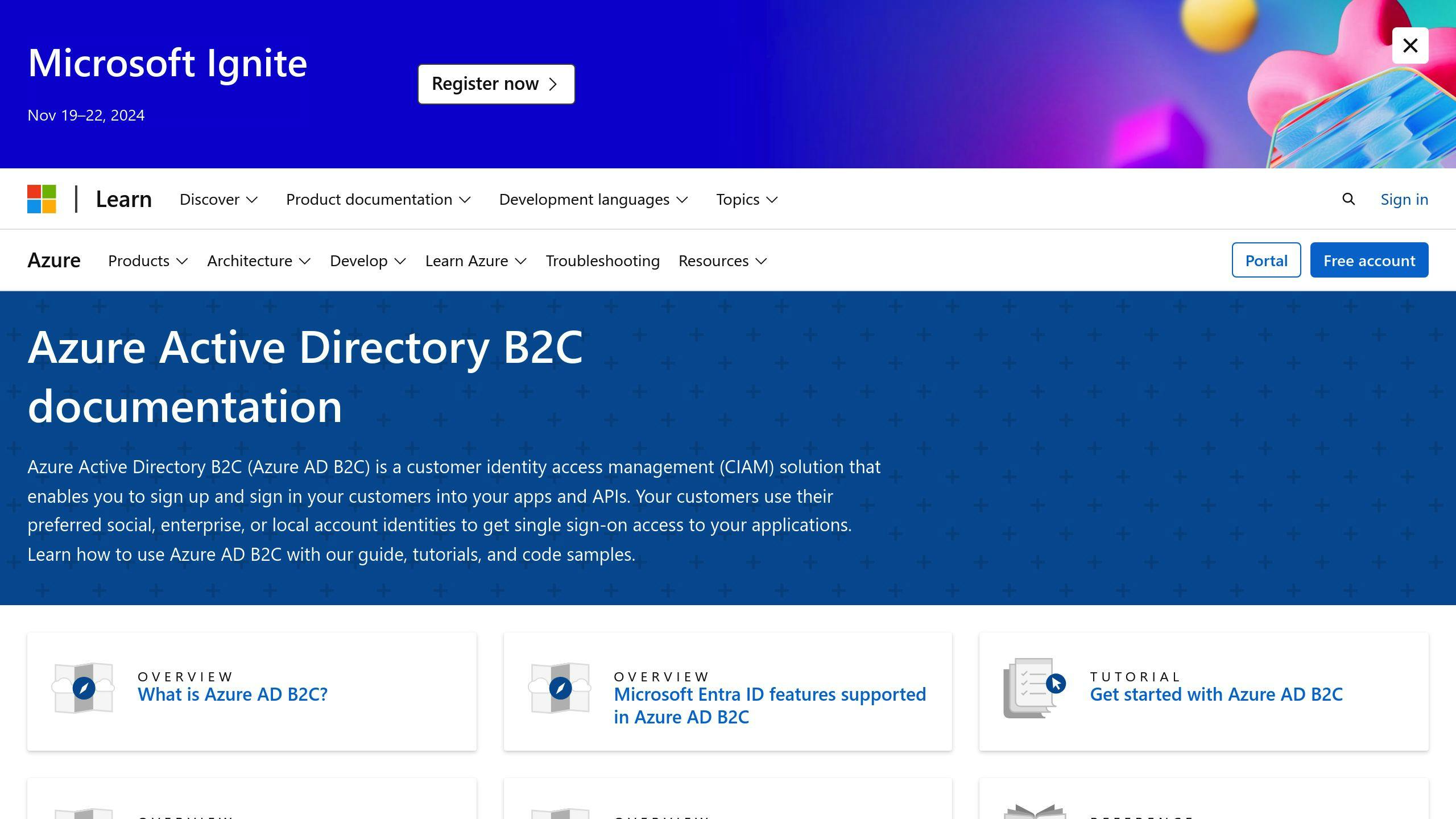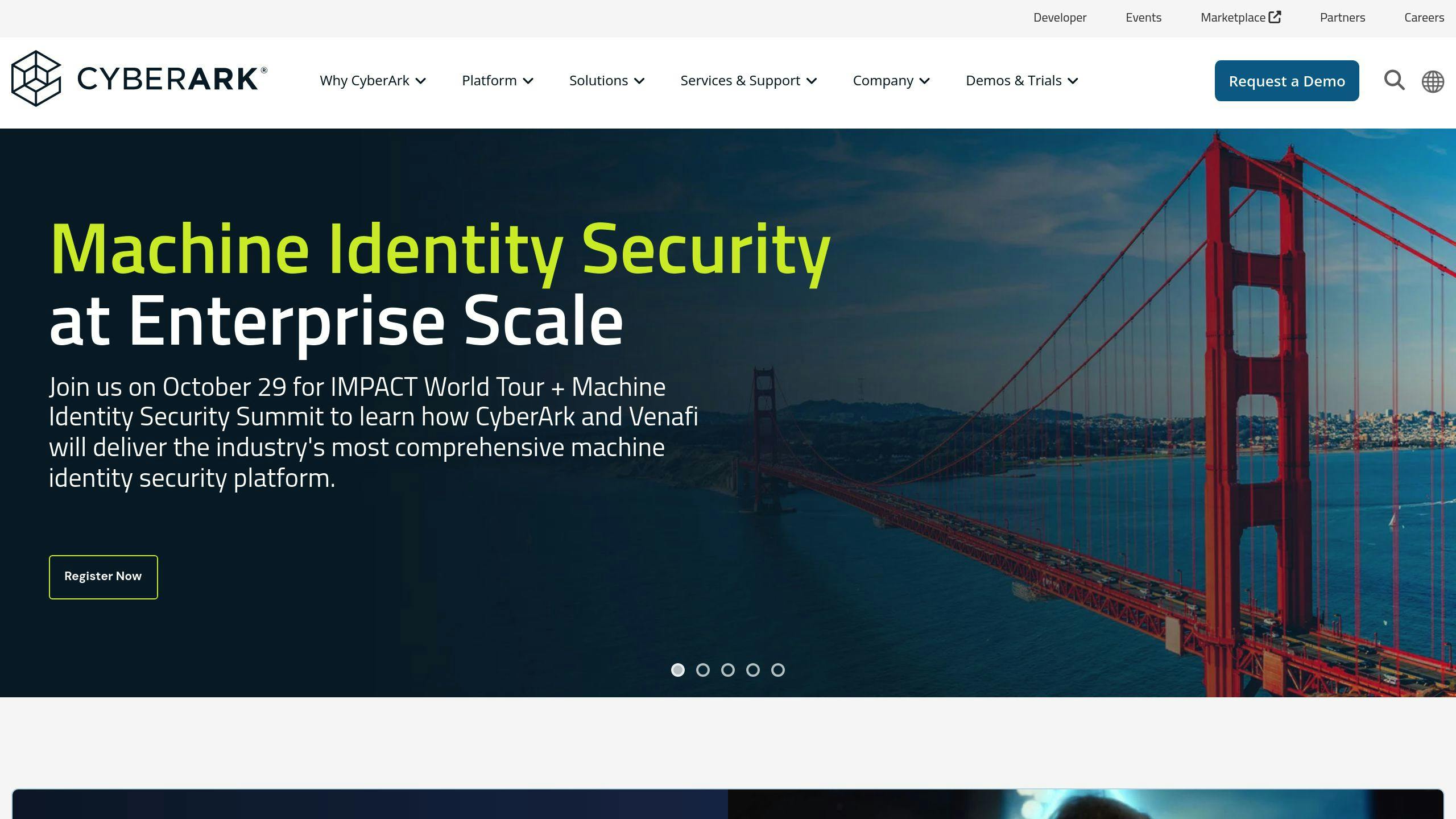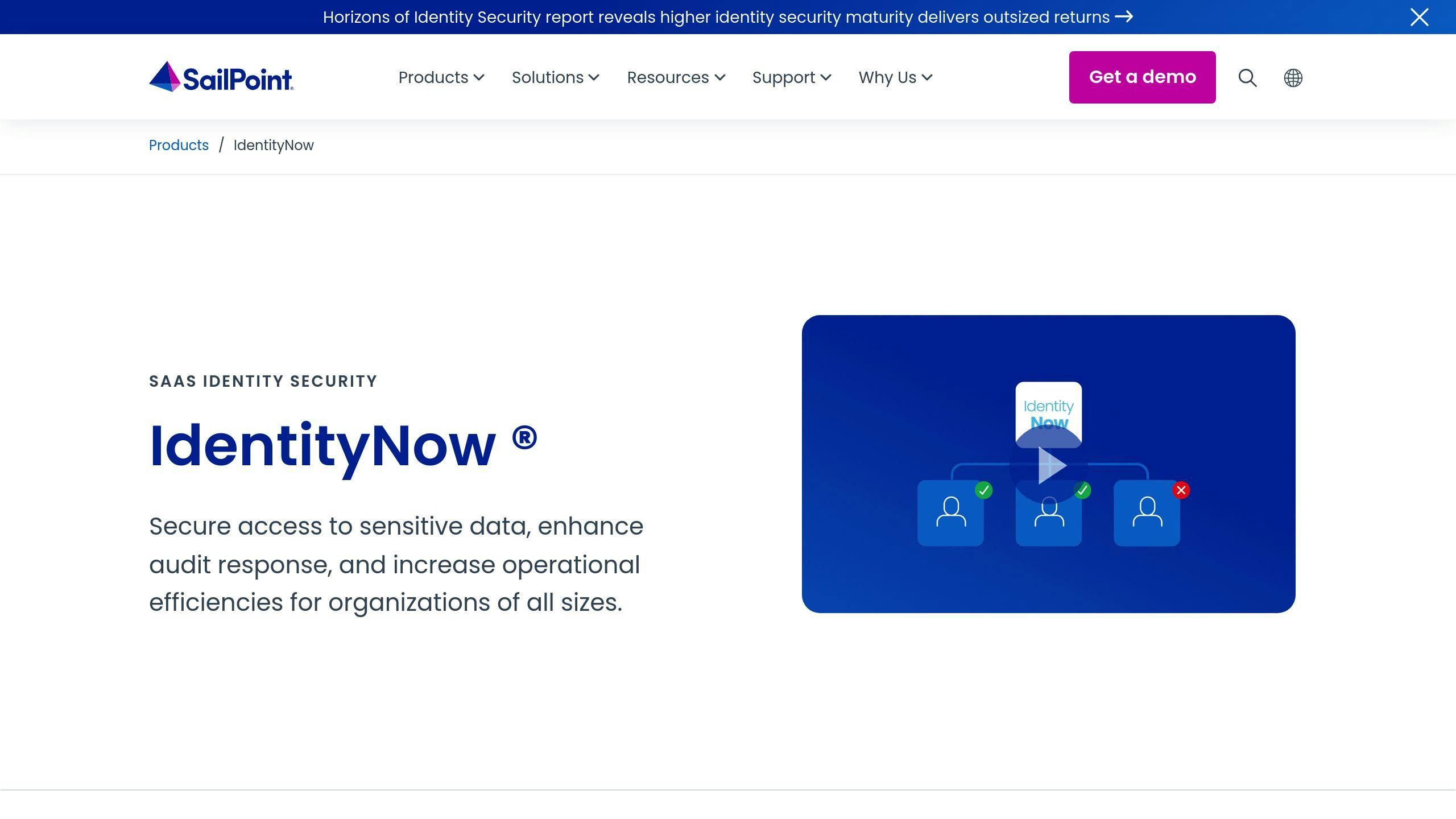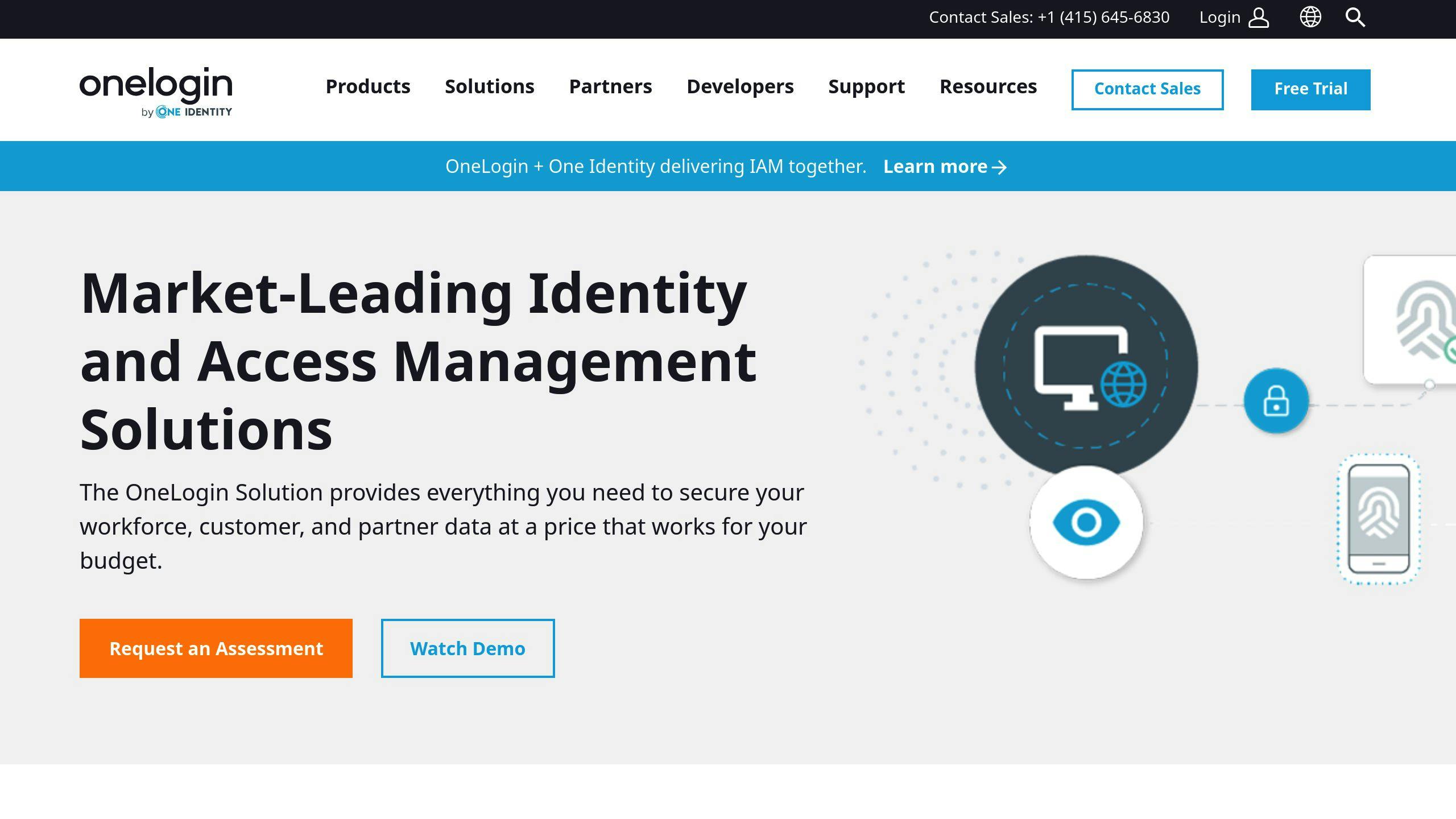7 Best RBAC Tools for SaaS Applications 2024

Need to control who can access what in your SaaS apps? Here's a quick breakdown of the top RBAC tools:
| Tool | Best For | Starting Price |
|---|---|---|
| Okta Identity Cloud | Large enterprises, 7000+ integrations | $2/user/month |
| Azure AD | Microsoft ecosystem users | Free with Office 365 |
| CyberArk Identity | Security-focused companies | Custom pricing |
| SailPoint IdentityNow | Mid to large companies | Custom pricing |
| Endgrate | API-first companies, 100+ integrations | Free tier available |
| OneLogin | Small-medium teams | $2/user/month |
| JumpCloud | Multi-OS environments | Tiered pricing |
Key Features All Tools Share:
- Single Sign-On (SSO)
- Multi-Factor Authentication (MFA)
- Role-based permissions
- Audit logging
- API access control
Quick Comparison:
| Tool | Integration Count | Security Level | Setup Complexity |
|---|---|---|---|
| Okta | 7,000+ | High | Complex |
| Azure AD | 3,000+ | High | Medium |
| CyberArk | 500+ | Very High | Complex |
| SailPoint | 1,000+ | High | Medium |
| Endgrate | 100+ | Medium | Easy |
| OneLogin | 2,000+ | Medium | Easy |
| JumpCloud | 700+ | High | Medium |
Pick Okta or Azure AD for enterprise-grade security, OneLogin for smaller teams, or JumpCloud if you need to manage different types of devices. Want API power? Go with Endgrate.
Related video from YouTube
Okta Identity Cloud: Core Features and Uses

Okta Identity Cloud is a web-based SSO system that lets users access multiple apps through one dashboard. Since 2009, it's been helping companies manage user access and permissions.
Here's what you get with Okta:
| Feature | Description | Benefit |
|---|---|---|
| SSO Integration | Connect to Gmail, Office 365, Salesforce | Log into 6,500+ apps at once |
| Multi-Factor Auth | OTP, push alerts, biometrics | Better security |
| Policy Engine | Set permissions by job/department | Control who sees what |
| Session Security | Location checks (ASN/IP) for admins | Stops token theft |
| Workflows | Auto user setup/removal | Less manual work |
The pricing breaks down like this:
| Plan Type | Cost per User/Month | What You Get |
|---|---|---|
| Basic SSO | $2 | Core login features |
| MFA | $3 | Extra security tools |
| Adaptive SSO | $5 | Smart access rules |
| Adaptive MFA | $6 | Top-level protection |
Heads up: You'll need to spend at least $1,500/year.
Security That Works:
- DPoP comes standard for API connections
- Admin sessions tied to location
- Full activity tracking
- Zero Trust built-in
Here's How It Works: Let's say you're a super admin at ExampleCorp. Setting up Workflows looks like this:
1. Make admin groups
2. Connect user info to Workflows
3. Hand out roles (Admin, Auditor, Connection Manager)
4. Set up automatic onboarding
Okta does three things really well:
| What It Does | How It Helps |
|---|---|
| Access Control | Manages roles, permissions, and monitoring |
| Security | Protects tokens, checks locations, spots risks |
| Reports | Tracks usage, flags issues, analyzes logs |
Want to use Okta? Start here:
- List your current systems
- Define your roles
- Plan your integrations
- Build your workflows
- Watch how people use it
If you need RBAC with SSO that just works, Okta Identity Cloud fits the bill.
2. Azure AD: Microsoft's Access Control Solution

Azure AD is Microsoft's cloud platform that manages who gets into your apps and data. Think of it as a digital bouncer that checks IDs and decides who can do what.
Here's what you get with Azure AD:
| Feature | What It Does |
|---|---|
| SSO Integration | Links to 3,300+ apps with one login |
| Identity Protection | Spots and blocks weird login attempts |
| Access Management | Controls who does what |
| Multi-Factor Auth | Makes users prove it's really them |
| Audit Logging | Records who did what and when |
Here's what it costs:
| Plan | Cost/User/Month | What You Get |
|---|---|---|
| Office 365 | Included | Basic ID controls |
| Premium P1 | $6 | More admin tools |
| Premium P2 | $9 | Advanced security + PIM |
Azure AD comes with ready-to-use roles:
| Role | What They Can Do | Who Uses It |
|---|---|---|
| Global Admin | Everything | IT bosses |
| User Admin | Handle users | HR people |
| Reader | Look but don't touch | Auditors |
| Custom Roles | Whatever you need | Special cases |
The Numbers You Need to Know:
- 2,000 role assignments per subscription
- 500 role assignments per management group
- 100 built-in roles to pick from
Setting It Up Is Simple:
- Pick where it applies
- Choose your roles
- Give them to people
- Watch what happens
Make It Work Better:
- Use the roles that come with it
- Put people in groups
- Keep an eye on who does what
- Clean up old permissions
Extra Security Stuff:
- Lock down admin accounts
- Set time limits on access
- Watch for weird behavior
- Pull reports when needed
If you're already using Microsoft tools or need serious access control, Azure AD fits right in. It's like having a super-smart security guard who never sleeps and follows your exact instructions.
3. CyberArk Identity: Security-First RBAC

CyberArk Identity puts security at the core of access management. Here's what you'll get:
| Feature Category | What You Get |
|---|---|
| Core Security | • MFA and passwordless login • SSO for web and mobile apps • Real-time threat detection |
| Access Control | • Custom role definitions • Policy-based permissions • Automated access provisioning |
| Integration | • Active Directory sync • Azure AD connection • API access management |
| Monitoring | • User activity tracking • Access pattern analysis • Security alerts |
The platform connects with 100+ pre-built apps, offers MFA and passwordless authentication, and syncs with AD, Azure AD, and custom directories.
Here's how it works:
1. User Management
The system pulls data from your directories (like Active Directory) and keeps everything in sync - no manual work needed.
2. Access Setup
You'll set up roles and policies based on:
- What people do
- Which department they're in
- How much access they need
- What devices they use
3. Security Measures
You get protection through:
- MFA for admin access
- Time limits on access
- Rules for specific devices
- Watching how apps get used
| Plan Type | Best For | Main Features |
|---|---|---|
| Basic | Small teams | SSO, basic roles |
| Business | Mid-size companies | Custom roles, MFA |
| Enterprise | Large organizations | Full security suite |
Want better security? Here's what to do:
- Turn on MFA for anyone with admin access
- Start with the pre-built app templates
- Look at your access logs every week
- Clean up old accounts once a month
CyberArk Identity fits companies that want tight security and single-point control. It's perfect if you're running Active Directory or Azure AD.
Users give it 4.22 out of 5 stars - proof that it delivers on both security and access management.
4. SailPoint IdentityNow: Cloud-Based Access Control

SailPoint IdentityNow combines AI and machine learning to handle identity security in hybrid IT environments. Here's what you get:
| Feature Category | Capabilities |
|---|---|
| Access Control | • Two-tier role modeling (Business & IT Roles) • Self-service access requests • Auto-provisioning and de-provisioning |
| Security | • AI-powered risk detection • Real-time access monitoring • Password policy enforcement |
| Compliance | • Detailed audit reports • Access certification • Policy management |
| Integration | • Cloud platform support (Azure, AWS, GCP) • Out-of-box connectors • API access management |
The platform's role-based system makes it stand out. Here's how it works:
1. Business Roles
The system sets up common roles like Manager or Security Analyst. Users get their access instantly when assigned a role.
2. Access Management
| Process | How It Works |
|---|---|
| User Joins | Auto-creates accounts and sets permissions |
| Role Change | Updates access based on new position |
| User Leaves | Removes all access immediately |
| Regular Review | Checks and updates permissions as needed |
3. AI at Work
The AI engine:
- Spots access patterns
- Flags suspicious behavior
- Helps with access decisions
- Compares permissions across peer groups
"With SailPoint, we now have a solution that also is harmonious with our cloud-first strategy."
| User Rating Category | Percentage |
|---|---|
| Excellent | 55% |
| Very Good | 40% |
| Average | 5% |
| Poor | 0% |
| Terrible | 0% |
Want the best results? Here's what to do:
- Start with both business and IT teams
- Give department heads control over team access
- Schedule regular access reviews
- Follow AI suggestions for role changes
"The certification module is perhaps one of the most valuable features. The options are pretty intuitive and you can usually set up the certification easily without much time or resource investment."
This tool fits best with large organizations that need strong identity controls and can handle a detailed setup process.
sbb-itb-96038d7
5. Endgrate: Integration-Focused Access Management

Endgrate simplifies RBAC by putting integrations first. Their API lets you control permissions across 100+ connected services from one place.
Here's what you get:
| Access Control Features | Description |
|---|---|
| Integration Management | Control access rights across 100+ third-party services |
| Single API Control | Manage all integration permissions from one dashboard |
| Custom Data Models | Set specific permissions for different data types |
| Security Standards | Top-level security for all connections |
The RBAC system breaks down into three parts:
1. Integration Access Levels
Think of these as permission tiers. Each level controls what users can do:
| Level | Controls |
|---|---|
| Admin | Full integration setup and user management |
| Manager | Integration settings and team access |
| User | Basic integration use with preset limits |
| Read-only | Can only view integration data |
2. Permission Settings
These are your day-to-day controls:
| Category | Capabilities |
|---|---|
| Data Access | Pick what integration data users see and change |
| Function Access | Control which features each role can use |
| Time Limits | Set when contractor access starts and stops |
| IP Restrictions | Lock access to specific networks |
3. Integration Management
Here's how you keep everything running smoothly:
| Feature | Function |
|---|---|
| API Keys | Create and handle access tokens |
| Usage Tracking | See how people use integrations |
| Audit Logs | Keep tabs on permission changes |
| Bulk Controls | Update many services at once |
You can pick from three plans:
- Free: Basic integration access
- Standard: Team-based permission management
- Premium: Advanced security features
Endgrate fits best if you're juggling lots of third-party services and want ONE place to manage them all. It's built for companies that connect to many external tools and need tight control over who can do what.
6. OneLogin: Single Sign-On and Access Control

OneLogin leads the Identity and Access Management space with 21,448 customers and 49.57% market share. Here's what their RBAC system does:
| Core Features | Description |
|---|---|
| Dynamic Provisioning | Sets up users in workspaces/roles based on their info |
| Just-in-Time Access | Adds users when they first log in with work email |
| API Controls | Manages roles and permissions in bulk |
| Multi-Factor Auth | Adds login security checks |
| User Lifecycle | Handles user access across all apps |
OneLogin's access control works in 4 main areas:
| Access Level | What It Does |
|---|---|
| User Management | Creates and manages roles and groups |
| App Access | Sets which users can use each app |
| Security Rules | Limits access by IP and time |
| Audit Tracking | Logs who does what and when |
The system has 3 main parts:
1. Role Assignment
OneLogin handles roles through:
- Login-time syncs
- Manual assignments
- Bulk API updates
2. Access Rules
| Rule Type | What It Controls |
|---|---|
| Workspace Rules | Who gets in based on user info |
| Role Mapping | Which roles users get |
| Time Windows | When users can access systems |
| Network Rules | Which networks can connect |
3. Pricing
| Plan | Monthly Cost Per User |
|---|---|
| SSO | $2 |
| MFA | $2 |
| Enterprise | Contact sales |
OneLogin fits best if you:
- Need one login for many apps
- Want to automate user setup
- Need SOC 2 and ISO 27001 compliance
- Have lots of different roles
With over 2,000 customers worldwide, OneLogin keeps things simple while staying secure. It works with both cloud and local apps through a single login.
7. JumpCloud: Directory-as-a-Service with RBAC

JumpCloud combines identity management and unified endpoint management into one cloud platform. Let's break down what their RBAC system does:
| Feature | Description |
|---|---|
| SSO Integration | Works with AD, Entra, Google, Okta at no extra cost |
| MFA Security | Built-in multi-factor authentication |
| Device Management | Controls access across Windows, macOS, Linux, mobile |
| Zero Trust | Environment-wide MFA with conditional access rules |
| SCIM Support | Automates user attributes and role assignments |
Here's how their admin roles work:
| Role Type | Access Level | Capabilities |
|---|---|---|
| Admin with Billing | Full | All system controls + billing |
| Administrator | High | All system controls except billing |
| Manager | Medium | User, device, group management |
| Help Desk | Limited | Password resets, user creation |
| Read Only | Basic | View-only access to resources |
The platform works through 3 main parts:
1. Identity Management
JumpCloud handles the basics: adding/removing users, managing groups, setting access rights, and updating permissions.
2. Access Controls
| Control Type | Function |
|---|---|
| Dynamic Groups | Auto-validates user/device entitlements |
| Custom Roles | Granular permission settings |
| Resource Access | Repository-level controls |
| API Management | Access token administration |
3. Security Features
| Feature | Purpose |
|---|---|
| Pre-built Policies | Ready-made compliance templates |
| Device Trust | Zero Trust device verification |
| Audit Logging | Track access and changes |
| Lifecycle Rules | Automated access updates |
JumpCloud works best if you:
- Need a cloud directory service
- Want to automate user management
- Need to control multiple device types
- Care about Zero Trust security
Tool Comparison
Here's a breakdown of the top RBAC tools and what makes each one different:
| Tool | Core Focus | Best For | Pricing Model |
|---|---|---|---|
| Okta Identity Cloud | Enterprise IAM | Large organizations | Custom pricing |
| Azure AD | Cloud-first IAM | Microsoft ecosystem | Tiered, starts free |
| CyberArk Identity | Security & PAM | Security-focused teams | GPL-3.0 license |
| SailPoint IdentityNow | Cloud Access Control | Mid to large enterprises | Custom pricing |
| Endgrate | Integration Management | API-first companies | Free to Premium tiers |
| OneLogin | SSO & Access | Small to mid-size teams | Per-user pricing |
| JumpCloud | Directory Services | Multi-OS environments | Tiered pricing |
Let's look at what each tool can connect with:
| Tool | Cloud Services | On-Premise | Third-Party Apps |
|---|---|---|---|
| Okta | AWS, GCP, Azure | Yes | 7,000+ |
| Azure AD | Azure-focused | Yes | 3,000+ |
| CyberArk | Jenkins, Puppet | Yes | 500+ |
| SailPoint | Major clouds | Limited | 1,000+ |
| Endgrate | 100+ integrations | No | API-based |
| OneLogin | Major clouds | Limited | 2,000+ |
| JumpCloud | AD, Entra, Google | Yes | 700+ |
Here's what security features each tool offers:
| Feature | Okta | Azure AD | CyberArk | SailPoint | Endgrate | OneLogin | JumpCloud |
|---|---|---|---|---|---|---|---|
| MFA | ✓ | ✓ | ✓ | ✓ | ✓ | ✓ | ✓ |
| SSO | ✓ | ✓ | ✓ | ✓ | ✓ | ✓ | ✓ |
| Zero Trust | ✓ | ✓ | ✓ | Limited | ✓ | Limited | ✓ |
| API Security | ✓ | ✓ | ✓ | ✓ | ✓ | Limited | ✓ |
| Audit Logs | ✓ | ✓ | ✓ | ✓ | ✓ | ✓ | ✓ |
Speed and scale matter - here's how the tools perform:
| Tool | Authorization Speed | Scalability | User Capacity |
|---|---|---|---|
| OpenFGA | < 1ms | High | Unlimited |
| Permify | < 10ms | High | Custom |
| Oso | < 50ms | Medium | Per plan |
| Casbin | < 5ms | High | Unlimited |
And here's what the open-source community thinks:
| Tool | Stars | License | Active Contributors |
|---|---|---|---|
| Casdoor | 8,685 | Apache-2.0 | High |
| Zitadel | 7,170 | Apache-2.0 | Medium |
| Cerbos | 2,533 | Apache-2.0 | Medium |
| Permit | 2,306 | Apache-2.0 | Medium |
Bottom line: Okta and Azure AD pack the most features for big companies. JumpCloud works great if you need to manage different types of devices. If you want to build your own system, open-source tools like Casbin give you that freedom.
Summary and Recommendations
Here's a no-nonsense guide to picking the right RBAC tool for your SaaS setup:
| Business Type | Best Tool Choice | Why It Fits |
|---|---|---|
| Large Enterprise | Okta Identity Cloud | 7,000+ integrations + top-tier security |
| Microsoft Users | Azure AD | Works perfectly with Microsoft, free to start |
| Security-First | CyberArk Identity | Built for high-security access control |
| Mid-Size Business | SailPoint IdentityNow | Born in the cloud, hits the sweet spot |
| API-Focused | Endgrate | 100+ API connections, modern stack |
| Small Teams | OneLogin | Simple pricing, 2,000+ tools connect |
| Mixed OS Environment | JumpCloud | Handles all devices, all platforms |
Here's What Matters Most:
1. Integration Check
Your tech stack needs to play nice with your RBAC tool. Look at:
- Current tool compatibility
- API options for custom needs
- Room to grow as you scale
2. Security Must-Haves
Every tool has MFA, but they're not all equal:
- Okta, Azure AD, and CyberArk lead in Zero Trust
- API security varies (see our comparison table)
- Each tool has different security extras
3. Money Talk
| What to Look At | Why It Matters |
|---|---|
| User Count | Some charge per person, others flat rate |
| Features | Basic vs premium - big price gap |
| Support | Often costs extra |
| Training | Don't skip this in your budget |
Getting Started:
- Lock down your most important systems first
- List out your roles BEFORE you switch
- Test with a small group
- Keep roles simple
- Set up alerts from day one
Bottom Line: Okta and Azure AD are the heavy hitters. Smaller teams? Check out OneLogin or JumpCloud - they're cheaper and easier to use. Need API power? Endgrate's your best bet with 100+ ready-to-go integrations.
Don't skip the audit trails - they're your safety net. Every tool here logs activity, but storage time and detail level change between them.
| Pick This | If You Want |
|---|---|
| Okta | Big business security + tons of connections |
| Azure AD | Perfect Microsoft fit |
| CyberArk | Security on steroids |
| SailPoint | Pure cloud power |
| Endgrate | API connection king |
| OneLogin | Easy + budget-friendly |
| JumpCloud | Works on all systems |
FAQs
What is RBAC management platform?
An RBAC (Role-Based Access Control) management platform controls who can access what in your system based on their job roles.
Here's how it works:
| Component | Function |
|---|---|
| Roles | Define access levels by job type |
| Permissions | Set specific actions allowed |
| Users | Get matched to roles |
Let's look at a real healthcare example:
| Role | Access Level | What They Can Do |
|---|---|---|
| Doctor | Full medical access | See all records, order tests, prescribe meds |
| Nurse | Basic medical access | Check vitals, write care notes |
| Admin | Business access only | Book appointments, handle billing |
The numbers show why RBAC matters:
26% of SaaS security problems come from inside threats. That's why many companies use Microsoft Active Directory for RBAC.
"Role-Based Access Control (RBAC) is a method of access control that assigns permissions to users based on their roles within an organization."
Here's what RBAC does for you:
- Reduces admin tasks
- Makes security checks simple
- Keeps data on a need-to-know basis
- Connects with your Microsoft tools
Want to set up RBAC? Do this:
- Write down your job roles
- Pick what each role can do
- Start simple
- Add more rules as you need them
Related posts
Ready to get started?
